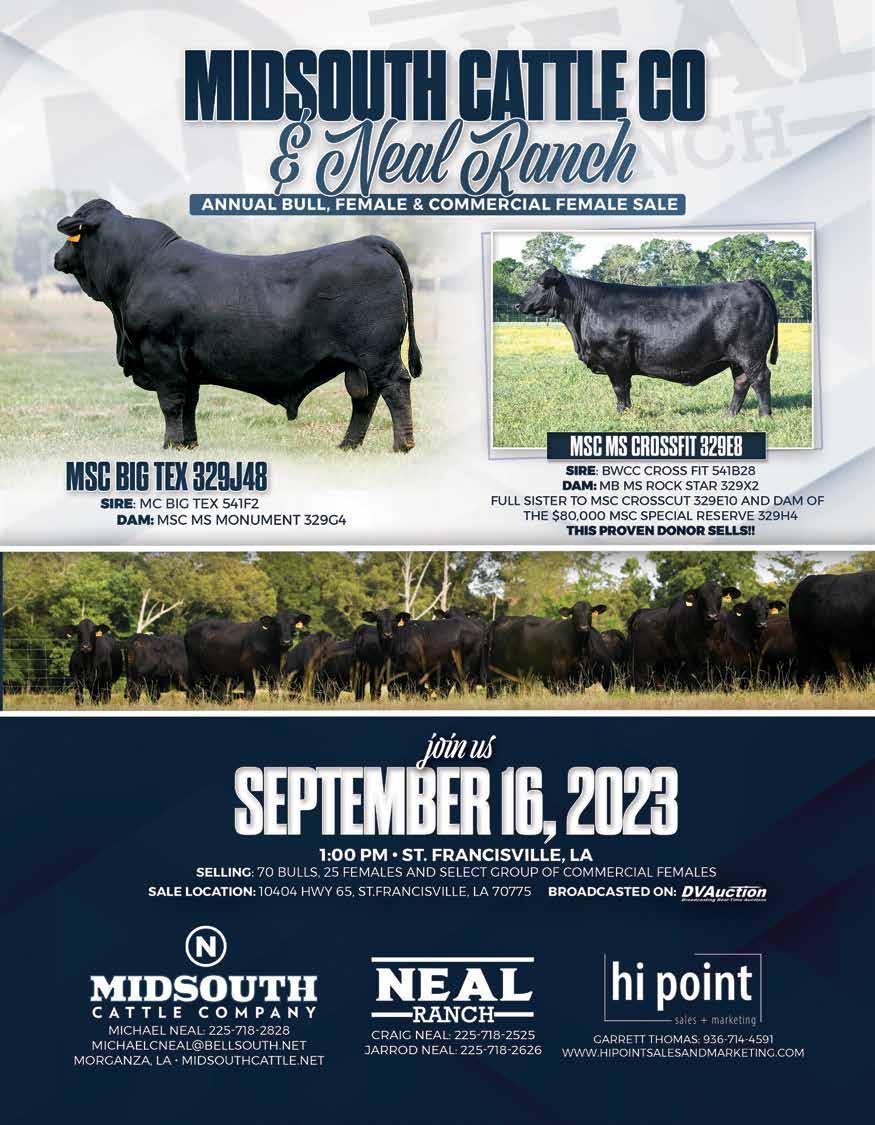Brangus JOURNAL






















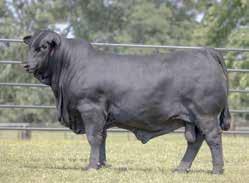
























IBBA 1st Vice President, Shiloh Hall, attended the National Cattlemen’s Beef Association Young Cattlemen’s Conference (YCC) program's relaunch after a three-year hiatus. Read more about the event on pages 24 & 26.
IJBBA Director, Emma Tittor, shares her experience planning and attending the IJBBA Legacy Conference and the impact it has on our junior members in the Brangus breed. Read more on pages 33-36.
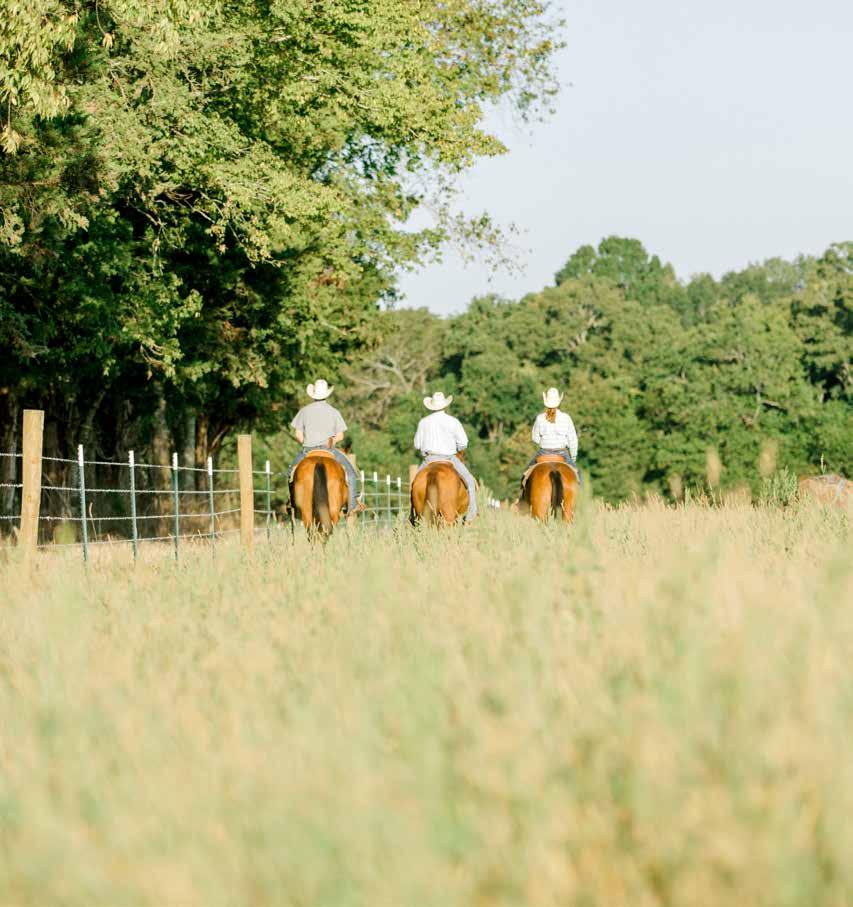
Evaluating EPDs globally on Brangus cattle. The broad picture of it is pretty cool to view. Imagine being able to add the EPDs of Brangus cattle from all over the world to our monthly EPD run at IBBA. But, how practical is it?
Featured on pages 42-44 are the results for the 2023 Texas Invitational in Bryan, Texas judged by Chris Sankey and Jojo Carrales.
 By Rob Singleton, International Brangus Breeders Association (IBBA) president
By Rob Singleton, International Brangus Breeders Association (IBBA) president

As I sit down to write this article, I can’t help but reflect back to last summer when a large portion of the country was suffering from severe drought, cow herds were being liquidated, input costs were through the roof, and the market for beef cattle was less than stellar. Oh what a difference a year makes. Moisture is far more favorable throughout most of cow country, and we are seeing record, or near record prices in all sectors of the beef cattle industry. Although I am thankful for this upswing, it comes with a challenge. That challenge is, we must stay focused on producing quality. We must stay focused on producing highly functional, profitable cattle that provide a great eating experience for our consumer. As we continue to gather more data from the Brangus Value Project, we are proving the merits of Brangus cattle to the industry. I truly believe that our Brangus cattle are on the cusp of a marketplace surge like we have never seen before! Friends, let’s stay focused on continuing to produce the right kind.
As you read this, fall sales will be right around the corner. I am expecting demand for Brangus bulls to be tremendous, and I hope to see many of you as I travel to sales this fall. As I meet and talk to people from other breeds and commercial producers, I am quick to tell them just how good our Brangus cattle are, and as I walked through the barn and watched the National Junior Brangus show, I was reassured that my feelings are correct. What a tremendous set of cattle!
As impressed as I was with the cattle at the NJBS, I was more impressed with our young people. They conducted themselves in a courteous and professional manner as they exhibited their cattle, as well as interacting with us old folks. The future is bright for our breed! My hat is off to Lori Edwards-Dunkerley and all the leaders involved with the juniors.
As always, your Board of Directors is only a phone call away if you have questions or concerns about the governance of our great breed. Lets stay focused on the task at hand, and GO BRANGUS!

Town Creek Farm bulls hold up, out-work, out-last and out-perform their peers. Fewer bulls to replace. Thirty-years of proven maternal performance bulls.
√ Select your bulls from proven Brangus (selection of 1st gen 3/8-5/8 bulls) Ultrablacks, Vigor Max™ (Brahman x Angus half-blood), 3/4 Blood and Brahman Bulls.
√ Opportunity to buy bulls from a program that culls EVERY open female and EVERY female that doesn’t bring a calf to weaning pens.
√ Cattle fit the commercial world, based on good cows behind our bull offering.
√ Maternal bulls develop superior replacement heifers that are fertile, long- lasting and have good udders.
√ Offering full two-year-old bulls.
√ Large selection of calving ease heifer bulls.
√ User-Friendly bulls.
√ Bulls are hard, ripped and toned; ready for breeding pastures.
√ Managed to be disease-free. ALL bulls are out of Johnes-free cows.
√ Environmentally adapted and acclimated bulls that withstand heat and humidity.

√ Longevity – of breeding bulls and of their daughters.
√ Fertility is our top priority. All other traits follow fertility.
√ Genetics developed and proven for more than 30 years.
√ Your source of maternal bulls.
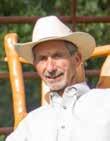
I can honestly say that we did not plan for the theme of this Journal to be LEADERSHIP. It just turned out that way.
In this issue of the Journal, you will read about the leadership event put on by our juniors, who broke the mold and did something totally different this year for their leadership experience. I tip my hat to the Junior Board of Directors, the Junior Advisory Committee and Lori Edwards-Dunkerley for putting on a great Legacy Conference.

We can all agree that developing visionary leaders within IJBBA is truly the future of IBBA and the Brangus breed. We all believe it – we all know it. Well, then, let’s expose them to parts of the industry that many of them have never seen before. Let’s challenge their young minds to envision a future in which Brangus cattle play a larger role from pasture to plate. Only by showing what happens beyond the ranch gate and beyond the show ring can we truly illuminate the big picture. I think all participants in the Legacy Conference came away with their heads spinning – full of big ideas and with a clearer picture of what happens “downstream” from a seedstock herd. I would wager a bet that more than one of the juniors who attended the 2023 Legacy Conference will someday serve on the IBBA Board, will chair IBBA committees and will sit in an officer’s chair. Does anyone want to take the other side of that bet?
Next up is Shiloh Hall’s leadership experience with the NCBA Young Cattlemen’s Conference (YCC). Shiloh served as a U.S. Marine, so leadership training is nothing new to him. But in this case he had the opportunity to connect with over 70 other young beef industry leaders as they traversed the country from Denver to Washington, D.C. It’s a nine-day adventure with very long days and very short nights, so it isn’t for the faint of heart. I do not know how aggressively IBBA has taken advantage of this event in the past. I know that Tracy Holbert attended the YCC when he was just a pup on the IBBA staff, but I do not know how
many others from Brangus have participated.
As Shiloh moves on in the leadership chairs of IBBA, I am very confident that what he experienced on the YCC will pay dividends for Brangus. In my humble opinion, this is an investment that IBBA should make every year. We should put it in the budget and begin recruiting participants years in advance of their YCC journey. In many state associations, there is active competition to be selected as the person to attend YCC.
Next up is Jeremy Jackson’s assessment of a global leadership opportunity that IBBA has been discussing for several years and has now taken a couple small steps forward. Namely, a Global Brangus Genetic Evaluation. It is just what the previous sentence says. It is a combining of all Brangus data from around the world into a single genetic evaluation. Jeremy was face to face with breeders from around the world when he was in Argentina for the World Brangus Congress. He heard the same thing I heard. Namely, there is great interest in this but it is a BIG step – one that needs to be fully understood before jumping into it. Jeremy’s article hits the nail on the head as to what IBBA needs to do before diving into this.
Finally, I want to recognize the collective leadership of IBBA members who have embraced genomic enhancement of their cattle. The Breed Improvement Committee held a webinar recently to celebrate eclipsing 50,000 genomic records in our database. This is clearly leadership, but it does not come from a person standing at the podium or chairing a meeting. It comes from individual breeders doing what they can do to make Brangus better. That’s leadership too. This article may seem as though I jumped around a lot. But the truth is, leadership is multi-faceted. It is never just ONE THING. It is the collective attitude and actions of many people who can envision and who are committed to a bright future. Brangus has a bright future.


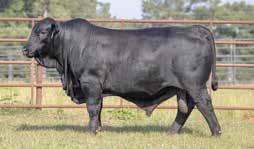


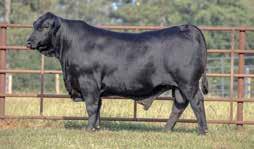



NOVEMBER 17-18, 2023 || JACKSONVILLE, TX

A TRADITION OF QUALITY


At Cavender Ranches, we’ve been involved in the Brangus breed for over 30 years and made a commitment to start feeding all of our cattle 25 years ago. We are both a seedstock producer and a consumer of our own genetics.


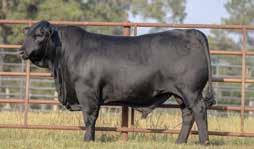







What a summer! Even though the Brangus Journal team took a break in June and July, field work never stops.
To kick off the month of May I traveled to Bunnell, Florida, home of Phillips Ranch for their 2nd annual female sale. The more time that I have spent out in the field getting to know Brangus breeders all over the country, the consensus seems to be that if you have a good sale year 1, you need to offer something truly spectacular in year 2 to avoid a “sophomore slump” of sorts. Those attending in person and watching online can attest, there was no sophomore slump in sight. The cattle looked incredible and grossed almost $700,000 across 63 lots! Truly an incredible sale, and a big congratulations goes out to IBBA President Rob Singleton and his team at Phillips Ranch for putting on another showstopper sale.
I spent the next week working in Louisiana visiting Michael and Lisa Neal of MidSouth Cattle Company in St. Francisville. The Neal family is a mainstay in the Brangus breed and go the extra mile every day to raise Brangus with the commercial cattleman in mind. The front gate and sale facility may not have a lot of frills but the quality of cattle speak for themselves- evoking a familiar sentiment from famous Brangus breeder Vern Suhn: “they come for the cattle, not the fancy trimmings”. Throughout my visit, it was evident Michael and Lisa do an exceptional job in customer education. Michael and Lisa’s tag-teamed speech over fetal programing and the importance of quality mineral supplementation was clearly one they have given to countless customers before; and if I had closed my eyes (and ignored the heifer trying to eat a non-existent cube out of my hand) while listening to them, I could’ve easily been back in Dr. Rathmann’s Beef Production course at Texas Tech. Midsouth will have their annual bull and female sale on September 16th and I greatly look forward to seeing how these cattle look on sale day.

The month of June flew by with travel on the calendar for every week. I started Week 1 by hopping over to Ruidoso for the New Mexico Cattle Growers Mid-Year Meeting and Tradeshow. While there, I met up with Marty and Belinda Lavender, active IBBA committee members and owners of Lavender Brangus in Melrose, NM. We had a plethora of visits throughout the week connecting with commercial cattlemen from all over the state. After the tradeshow, I stopped in at Westall Ranch in Arabela, NM to meet manager Tate Pruett. The ranch, sitting at the foot of the picturesque Capitan Mountains, is home to the historic Brinks Brangus herd. Purchased by owner Ray Westall from the famed Camp Cooley Ranch back in 2012, Mr. Westall and Tate have done an excellent job adapting the herd to the rough and rocky terrain of New Mexico. The Brinks Brangus herd at Westall Ranch is a testament to the ability of Brangus to not only survive but thrive in any environment in the world.
continued on page 18

From there, I drove back to Roswell and hopped another flight to Birmingham, Alabama for the Quail Valley Farms Elite Female Sale. This was a great capstone on the spring sale season with another outstanding set of mature females and heifers for sale. A good Brangus female never goes out of style. As the national cattle herd looks to rebuild after a rough last few years, the Brangus female looks to be in an advantageous position. Next up was the Florida Cattlemen’s Convention in Marco Island, FL which far and away has to be one of the best cattle-related trade show in the country. I had some great conversations with producers across the state regarding our strategic initiatives like Brangus Value Project and commercial programs like Brangus Vigor and Brangus Built. I look forward to my trip back next year.
Last but not least, the IBBA staff went up to Chickasha, Oklahoma to help put on the National Junior Brangus Show. I exhibited market animals in high school, but this was my first junior national show with the IBBA. Youth in agriculture are the future of our industry and I always enjoy getting to see these kids give it their all during show weeks, whether it be exhibiting their animals in the show ring or competing in a costume contest. This NJBS was certainly one for the ages. Great job to IBBA Director of Shows and Youth Activities, Lori
Edwards-Dunkerley, and the junior board, with the help of the show committee for putting on one heck of an event.
At the time of writing this, I am returning from a trip to Cargill Meat Solutions- Dodge City, KS collecting Brangus loin steak samples for tenderness testing as a part of the Brangus Value Project. The cattle graded well again in the second round and will go a long way in helping us develop new EPD’s for traits like Marbling Score, Carcass Weight and Tenderness. Once we got the carcasses graded, graduate students from Texas Tech University and I worked with plant employees to catch the carcasses as they came off the grading chain and rail them off to a separate area of the cooler to cut the 2-inch steak samples out of the loin. As we were collecting the samples, the General Manager happened to be walking by and we struck up a conversation. As we strolled down the rail of mostly Upper 2/3rds Premium Choice Brangus and Ultrablack carcasses, I explained the parameters and goals of the Brangus Value Project. On two separate occasions, he said “I can’t believe THESE are Brangus”. These types of conversations are the ones I love to have. Even though these cattle had a little more ear and sheath than their neighbors in another pen, none of that matters when the hide comes off. I am very eager to receive the slice shear force data back from our friends at Texas Tech to help us keep telling this awesome Brangus story.
On a personal note, in between travelling to see Brangus breeders, attending sales and tradeshows and the Brangus Value Project, I found some time to coach the local Natchitoches Parish 4-H Meat Judging Team to a State Champion finish! These kids will go on to represent Louisiana at the National 4-H Meat Judging Contest at Kansas State University in October.
Next up on the calendar I will be travelling north to the Superior Livestock Video Royale Sale in Winnemucca, NV supporting those selling Brangus calves and learning more about how Brangus succeeds in that region. Shortly after, I will attend the Beef Cattle Short Course in College Station before driving up to Lubbock for a Breed Improvement Committee meeting and on the way back to Louisiana stopping in GKB Ranch in Desdemona for the Texas Brangus Breeders Association Field Day on August 11th and 12th. I’ll also make a trip up to Chimney Rock Cattle Company to attend the Southeast Brangus Breeders Association Field Day August 18th and 19th. Fall sale season is almost here! I look forward to seeing everyone at the upcoming field days and sales. Check out the calendar on page 52 for upcoming events! GO BRANGUS!


Association (IBBA) executive vice president
I am frequently asked why EPDs change on an animal for traits that have not yet been measured. An example would be a weaning weight or yearling weight EPD that differs from the parent average EPD even before a weaning weight or yearling weight has been recorded. Such situations are usually due to the effect of a genetic correlation in the model used to compute EPDs.
A Genetic Correlation exists when two traits are affected by some of the same genes. An easy-to-comprehend example is weight traits. If a calf is born with an unusually high birth weight, the statistical model will cause its weaning weight and yearling weight EPDs to move upward from the parent average even though weaning weight and yearling weight have not been recorded yet. This is because some of the same genes that cause a calf to have a large birth weight are expected to have the same effect on its weaning weight and yearling weight. If that same animal (surprisingly) records a low weaning weight and a low yearling weight, its WW and YW EPDs will go down
and the model will cause its BW EPD to go down also. If one could put the actions of the statistical model in plain English, it would sound something like this: “I thought this calf had high genetic merit for growth because it had a large birth weight, but then it surprised me with low WW and YW, so I guess it doesn’t have as many growth genes as I thought, so I’m going to lower it’s genetic prediction for BW too.”
As breeders, we tend to appreciate some genetic correlations and fight against others. Again, weight traits are an easy-to-understand example. Most breeders want cattle with more early-life growth potential. A heavy weaning weight suggests that an animal will also have a heavy yearling weight, both of which are considered to be good by most breeders. The downside is that heavier birth weights and heavier mature cow weights tend to come along with heavier weaning and yearling weights. Most breeders don’t want heavier birth weights and bigger cows. The good news is that the genetic correlation between birth and weaning weight, for instance, is not 100%.

There is not a one-to-one relationship. In IBBA’s statistical model, the genetic correlation between BW and WW is 0.33. So, this means that BW and WW have a tendency to move in the same direction, but that is not carved in stone. There are animals (frequently referred to as curve-benders) that have genes for moderate BW and genes for heavy WW.
When you see a sire with fairly high accuracy values for both BW and WW, and with low BW and high WW EPDs, you can be fairly certain that he is a true curve-bender and if you stack pedigrees with such animals, you will have a population of cattle with moderate BW but stout WW. The Neogen/IBBA model is effective at identifying such animals, and breeders have obviously used them because our genetic trend for BW is flat, while the genetic trend for WW slopes nicely upward over time.

A very significant feature of genetic correlations is that they allow us to produce a fairly reliable EPD for a late-in-life trait (such as Stayability or Number of Calves) by using data on early-in-life traits such as Heifer Pregnancy or Breed Back.
The IBBA Number of Calves EPD is expressed as the number of calves produced up through 7 ½ years of age. We really don’t want to wait until a cow is 7 ½ years old before having
an estimate of her likelihood of making it to 7 ½ years of age. That’s like showing up at the football stadium after the game is over. The genetic correlation between Breed Back, measured as soon as a cow records her second calf, and Number of Calves is 0.85. You don’t need to be a statistician or a genetics nerd to understand that a correlation this high is very telling. Because it is so high, we can produce a fairly reliable EPD for Number of Calves as soon as a cow records her second calf. Or, to be more realistic, if a sire’s daughters have a very high Breed Back EPD, we can be fairly certain that they have what it takes to remain productive through 7 ½ years of age.
I’ll close this essay with one message. I talk to far too many people who think they can look at raw phenotypic data and out-smart the computed EPDs for the traits they’re looking at. Even with a firm understanding of genetic correlations, heritabilities, adjustment formulae and everything else that goes into EPD computation, you simply cannot do that much math in your head. There’s an old bit of sage advice of which I’m not sure of the source, but it goes something like this: “the race is not always to the swift, nor the battle to the strong, but that’s the way to bet”. If you want to make steady and predictable genetic change, bet on EPDs.
Glen Roy Urban, Pleasanton, Texas passed away March 29, 2023 at the age of 75. He was born in LaGrange, Texas on Feb. 16, 1948 to Julius Anton Urban and Hertha (Friemel) Kruse.

Glen Urban was preceded in death by his grandmother, Nora Friemel. He is survived by his mother, Hertha Kruse; daughters, Mandy Wheeler and husband Lanny and Chelsea Harvey; grandchildren, Eric Wheeler, Alexis Wheeler, Alexandria Wheeler, Lindy Wheeler, Tristan Harvey and Brielle Harvey. Urban graduated from Texas A&M University with a degree in agriculture in 1976. He was part of many organizations that he loved, especially the International Brangus Breeders Association, Pro Rodeo Cowboys Association, Texas A&M Saddle & Sirloin Club, Texas Youth Rodeo Association and was also inducted into the South Central Texas Rodeo Ring of Honor. He was a rodeo clown for many years starting in the early 70's. He worked for Sloan Williams and Tommy and Bobby Steiner clowning at amateur to professional rodeos. Later in life, he was a cattle broker until almost the day he passed away. He spent his time traveling to his grandkids' sporting events and being part of their lives.
A celebration of life was held April 22, 2023, at Christine Baptist Church, Christine, Texas. In lieu of flowers, please consider donating to the Texas Youth Rodeo Association(TYRA) at P.O. Box 886, Caldwell, Texas 77836, in honor of Glen Urban.
champions over the years. Always an "outdoors" guy, he enjoyed hunting and fishing.
“Laverne was my first teacher in the cattle business— not only was he my teacher, but he was a great friend. Laverne was one of those unique individuals who could get a cow herd up to be worked without any undue excitement. He had a psychological connection with the cattle and never got them stirred up. He started with Brinks Brangus shortly after we purchased cattle from the Riverby Ranch. He was the person who purchased an original Clear Creek cow and calf who turned out to be Brinks Mac Titan 6/4. We recognized the calf as being special and made an agreement with Laverne to work in Brinks program and own the bull with him,” remembers Glenn Brinkman, Brinks Brangus.
By most folks’ accounts and Brangus history, McWilliams single-handedly changed the Brangus breed, with that one bull. He saw him as a 6-month old calf on the side of his mother and bought the pair. The bull calf at side was registered as Mac Titan 6/4. His daughter, Debbie, remembers her dad sitting at the table with their dictionary, which was about a foot deep, looking from page to page, for a name for this young calf. He knew it would have to be something “magnificent” since this bull was going to make his mark in this breed! When he saw “Titan” in the dictionary, he declared that would be the bull’s name!
Ray Laverne McWilliams, 89, of Medina, passed away on Thursday, April 13th in Kerrville, Texas. He was born in Hope, Arkansas to Hubert Ray and Bessie Mae McWilliams on June 7, 1933. He married Clara Ann Sentesi on Sept. 16, 1955 in Westfield, Texas.

McWilliams, who received the International Brangus Breeders Association Pioneer Award in 2016, learned early of his affinity for working with animals and spent much of his life in the registered Angus and Brangus cattle business where he gained a reputation for breeding and exhibiting numerous

Titan and his progeny soon became the hottest commodity in Brangus, being ahead of their time. His impact on the breed was tremendous, but one particular calf crop and day still stands as a very historic event in Titan’s influence. At the 1983 Houston International show, three bulls all sired by Titan — Extra, Tremor and King — vied for the coveted title. To say the show was intense is not even a fitting description as the judge walked back and forth through the bulls. At any other point in the breed’s history any of these bulls could have dominated, but here they were at one time. The judge, after much discernment would pick Extra as champion, Tremor as reserve and all three would go onto make their mark. The Brangus breed, which was really just gaining recognition in the industry at the time, was the real winner.
He is preceded in death by his parents, Ray, and Bessie, along with his brother, Donald. Laverne is survived by his wife of 67 years, Clara Ann; children, Marshall and wife Sandra of Medina, Texas; Debbie McWilliams Fry and husband Ty of Fenton, Michigan; sister-in-law Eleanor McWilliams of Huntsville, Texas; four grandchildren and six great grandchildren, as well as numerous nieces and nephews.
Funeral services were held April 19th at the Medina Community Church with Pastor Bill Stegemueller officiating. Burial was
at Oak Rest Cemetery in Medina. Pallbearers were Aaron Theiss, Don McWilliams, James Cravatt, Josh Cobb, Matthew McWilliams, Parker Ray McWilliams, Steve Cody and Ty Fry. Honorary pallbearers were Craig Green, Gary Cross, Glenn L. Brinkman, Kent Smith, Paul Philley, Terry Reagan and Tracy Holbert. The family asks that memorials be given to The Blessing Fund, 250 Cully Drive, Kerrville, Texas 78028.
Nancy Pruitt, nationally recognized cattle photographer, passed away on May 13, 2023, in Fort Worth, Texas, following emergency brain aneurysm surgery. Pruitt lived in Springtown, Texas at the time of her death. She was a 1976 graduate of Texas A&M University with a degree in agricultural journalism.
In 1977, she joined the staff of Brangus Journal and part of her responsibilities required taking cattle photos. This opened another avenue of creativity for her, as she was already writing and designing ads and eye-catching layouts for the monthly magazine. Pruitt loved the photography part of her position, and it would become a lifelong passion. She also began drawing and painting cattle during this time.
She would leave Brangus in 1980 to join the editorial staff at The Cattleman. From there she would take advertising positions at Granada and Camp Cooley Ranch, where her photography and design skills produced award winning campaigns and her work was recognized on a national level. She became a sought-after cattle photographer across breeds, and this led her to open her own company that she operated until her death.
Pruitt was an avid horse enthusiast and competed in stock horse events. She was also active in a community Bible study in the Springtown area, and she helped many aspiring cattle photographers.


She annually served as a judge for the Fort Worth Stock Show Commercial Heifer Sale Scholarship program. Because of her commitment to that program, a scholarship has been established in her memory as part of the Fort Worth Stock Show Commercial Heifer Sale. It will be presented annually at the sale on the closing day of the Fort Worth Stock Show and Rodeo. Those wishing to contribute should make the check payable to Weekly Livestock Reporter, P.O. Box 7655, Fort Worth, Texas 76111. Please denote that the funds are to be used for Pruitt’s memorial scholarship.
A private burial was held in Dallas, Texas on May 22nd. She is survived by her son, Brett.

Mary Wallace Moore, 73, passed away peacefully on Tuesday, May 16, 2023, at her home in Houston, Texas. She was born November 17, 1949 in Pittsburg, Pennsylvania to Guy and Betty (Hileman) Wallace. She attended Indiana University of Pennsylvania and earned her bachelor's degree. Mary married the love of her life, Tom Moore, on December 16, 1972. Together, Tom and Mary founded their family business, Specialty Heat Treat, Inc., in 1993 where Mary worked until early 2023.
Mary lived her life to the fullest. She loved her work, traveling, cooking, quilting, and spending time at the beach. Mary & Tom loved fly fishing for bonefish, where she turned into a bow hog much to Tom’s delight. She was always up for a party and never missed an opportunity to host her family and friends. The greatest joy in her life was her family. She enjoyed visiting with her siblings and catching up on the lives of her nieces and nephews. She treasured the time she spent with her children and their spouses. Mary, also known as Bubby by her grandchildren, always cherished her time with each of them; watching them play sports, dance, at their school performances, doing puzzles, and being together at the lake.
She is survived by her husband, Tom Moore of Houston; children, Sam Moore and his wife, Janna Moore of Houston, Matthew Moore and his wife, Ashley Moore of Tomball, Grace Laird and her husband, Jim Laird of Tomball; grandchildren Sam Moore Junior, Max Moore, Emma Moore, Brady Moore, Paige Laird, Kate Laird, and Mary Elizabeth Laird; her siblings, Guy Wallace and sister in law, Sandy Wallace of Tomball, Janet Deschamps and brother in law, Rodney Deschamps of Cypress, Carol Einkauf and brother in law, Bob Einkauf of Cypress; plus numerous nieces, nephews, great nieces & nephews that she loved dearly.
She is preceded in death by her parents, Guy and Betty Wallace. The family would like to thank her caregivers, Ruby Osborne and Nikki Callicott for the loving care that they gave Mary at the end of her life. Family, friends, and others whose lives she touched were invited to Pines Presbyterian Church located at 12751 Kimberley Ln, Houston, TX 77024 on Tuesday, May 30, 2023 at 2:00pm for her celebration of life service. In lieu of flowers, please send donations to Mass General Calciphylaxis Research Program

 by Shiloh Hall, IBBA 1st Vice President
by Shiloh Hall, IBBA 1st Vice President
The National Cattlemen’s Beef Association Young Cattlemen’s Conference (YCC) program concluded its successful relaunch after a three-year hiatus. This year’s class included 71 leaders from across the nation and every segment of the beef industry, and I was very lucky to be one of them. After nine days of intensive leadership training and a five-city tour which showcased every facet of the beef industry, these leaders completed their trip with a full day of representation in Washington, D.C. The event is designed to give participants exposure to the full supply chain. Completion of YCC prepares participants to serve as leaders within their state associations in addition to being advocates for NCBA and the beef community.
The 2023 class began its journey in Denver, CO, with classroom sessions designed to provide background knowledge about NCBA and the work it conducts on behalf of its members and the beef community. In Denver, participants took part in leadership development sessions, media training, and hands-on demonstrations of the work NCBA does as a contractor to the Beef Checkoff. The group also made a visit to Greeley, CO, to tour Five Rivers Cattle Feeding’s Kuner Feedyard and enjoyed an evening with Trent Johnson and the outstanding staff at Greeley Hat Works.
The challenges facing cattle and beef producers increase every day. Part of NCBA’s role, and an important part of our

continued on page 26


success, is the ability to identify and develop leaders while also preparing them to meet these challenges head-on. Developing the next generation of leaders is just one of the ways that NCBA continues to protect and enhance the cattle business. The YCC program helps participants develop their leadership skills, while also exposing them to the full value chain in a way that not many producers get to experience. In Nebraska and Ohio, YCC participants had the opportunity to visit Tyson Food’s Dakota City beef processing plant, the headquarters of Certified Angus Beef and Wendy’s restaurants. Stops in these locations allowed the group to gain a better understanding of the full beef value chain, from processing through marketing and consumer outlets for beef. The 2023 YCC class finished its itinerary in Washington, D.C., where participants learned how NCBA’s policy work impacts their
operations and the broader industry. After an in-depth policy issue briefing from NCBA’s lobbyists and staff experts, participants took to Capitol Hill, visiting more than 200 congressional offices to advocate for industry policy priorities. Over these 9 days I realized how important it is as beef producers to get involved or stay up to date with current laws trying to be passed at both state and national level. For example, we are in the farm bill year that gets revisited every 5 years, The Democrats have tacked on 85 billion dollars of SNAP funds to the bill which is making it hard to get the farm bill passed. Every republican representative I met with said they are against passing a new farm bill with those funds attached to it. I really encourage everyone to stay up to date with NCBA, I have a new appreciation of what they are doing daily to protect the beef industry.




When it comes to marketing calves, there are several factors that can impact the final price that is garnered by a producer. The previous issue of CattleFax’s Trends discussed how producers can increase calf prices through value-added programs as well as utilization of various marketing avenues. Keeping with the same concept of adding value to calves, this discussion will be centered around how weaning and vaccination protocols can impact calf prices.
Weaning protocols can differ greatly from operation to operation, here the focus is primarily on the length of the weaning period. Results from the most recent CattleFax Cow-Calf Survey indicated that 57 percent of producers weaned for 45 days or more in 2022, this is up around 6 percent from 2021. Year after year weaning proves to be beneficial to both the calves as well as the producers bottom line in several different ways. One benefit of an extended weaning period is that it allows a producer to better take advantage of the seasonality in the calf market. In most years, the market typically finds a low sometime in the month of October. The reason for this is because the volume of calves on the market during this timeframe is usually at its peak. After October the prices usually trend higher throughout the balance of the year and on into the next. In 2022, the October calf market low was around $191/cwt, while one month later prices had rebounded to $196/cwt.

Along with potentially capturing higher prices, weaning calves allows producers more flexibility in marketing calves. The are numerous global and domestic factors that can impact the market week to week, calves sold directly off the cow may be sold in a week when the market was responding to negative fundamentals. Whereas a longer weaning interval would allow producers to better choose a marketing window and potentially avoid short-term market weakness.
Cattle feeders, stocker operators, and backgrounders for the most part, prefer weaned calves over unweaned calves. Weaned calves are typically lower risk from
an animal health standpoint which results in lower morbidity and mortality rates. Performance also tends to be better in weaned calves, particularly in a feedlot or backgrounding setting, as these cattle typically are able to get to a “full feed” schedule more quickly than bawling calves. Ultimately, more bidders interested in a set of calves typically correlates to higher prices. While there are certainly benefits associated with weaning programs of 45 days or more, these benefits do not come without added costs and risk. However, results from the Cow-Calf Survey would suggest that producers are generally rewarded for taking on the additional costs and risks. 2022 survey results showed that calves weaned for over 45 days had an average value of $1073/head, which would be $115/head more than the average value of calves shipped directly off the cow. This result has been consistent every year that the survey has been conducted. And while weaning may not be the only determinant to calf value, results from the survey support that weaning is likely a significant factor in calf prices.
If weaning protocols are implemented, it is crucial that these programs last at least 45 days. Again, looking at the survey results, calves weaned for less than 45 days had significantly lower values than those calves that were weaned for longer periods of time. Calves that
were weaned for less than 30 days had an average value that was discount to the value of shipping calves right off the cow. Weaning for 30 to 45 days only added $4 more dollars to the average calf value when compared to not weaning at all. This would not be nearly enough premium to make up for the additional risk and costs being incurred by the producer by weaning. Shorter weaning periods also don’t do producers any favors from a weight standpoint, as calves are not necessarily given the appropriate time to regain weight lost early in the weaning process. Another supporting factor for longer weaning periods is that it may help calves qualify for value added programs. Some of these programs require a minimum of 45 days, while others call for 60 to 90 days.
Much like weaning, vaccination protocols can be quite different between operations. The CowCalf Survey specifically looked at how many vaccinations producers elected to give to calves. Most respondents indicated that calves were vaccinated twice. Those who vaccinated once made-up 30 percent, or the second largest group of respondents, while 22 percent of respondents vaccinated three times. Not surprisingly the smallest group of responses are found at the extreme points with 1 percent of responses vaccinating four times and 5 percent not vaccinating at all. The survey also examined how calf values were impacted by the number of times that calves were vaccinated. Similar to previous years, the 2022 survey again finds that there is a positive correlation between the number of times vaccinated and calf values. Calves that were not vaccinated were $78/head discount to those that were vaccinated just once. The largest jump in calf values comes between calves that were vaccinated once and those that had two rounds of vaccines where there was a difference of $136/head in average calf values. While calf values still increased for the three and four times vaccinated groups, they do so at a much slower rate. Along with improving calf values, vaccinating also helped improve the health of calves through critical

growth stages. Not surprisingly, healthier calves tend to be heavier at weaning weight. The survey found that calves receiving no vaccinations resulted in an average steer weaning weight of 505 pounds. Weaning weights jumped up 33 pounds when one round of vaccine was given. Between calves that were vaccinated once and twice there was an additional 38 pounds added onto average steer weaning weights.
There are certainly several benefits in implementing sound weaning and vaccination protocols, especially as it pertains to calf values. However, for the benefits to become realized, it is important that producers promote the details of their respective protocols to potential buyers. The more information buyers have on a set of calves, the more likely a producer is to be appropriately compensated for protocols that include longer weaning periods, received multiple rounds of vaccines, bunk breaking cattle, or anything else producers do to add value to their calves.
Calf prices are expected to continue higher for at least the next couple of years as supplies remain tight. Subsequently, profitability in the cow-calf sector is expected to improve relative to the past couple of years. However, during this time frame it will be important to continue to place an emphasis on sound management practices. This will ensure that no matter where the market goes, producers are receiving the most value for their calves as possible.






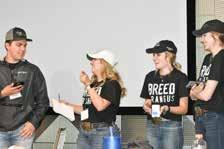



Last August at our IJBBA board training hosted by GKB Ranch in Desdemona, Texas a suggestion was made to host another Legacy conference, and details of what all that would entail was discussed. As a junior board member, I was excited to see this program come back to life and how it would impact our junior members in the Brangus breed. As someone who had never attended a conference held by the IJBBA it was interesting to hear stories of past events and because of those stories, I looked forward to being a part of planning this event. Hello everyone, my name is Emma Tittor and I am seventeen years old from Paradise, Texas, and have just started my second term serving as an IJBBA Director.
Once we decided to go forward with the planning of the conference, Dr. Wilkes gave us the idea to hold it in Kansas. Now my thought was, what is in Kansas that would relate to a bunch of Brangus kids. I was quickly informed that the Brangus Value research cattle were being housed at


The 2023 Legacy Conference was an experience like no other. We were blessed with the opportunity to meet new people, both friends and industry leaders, who will truly make an impact on our lives down the road. I’m thankful that this amazing breed has constantly given juniors an outlet for innovation and networking.
- Isabelle Parkey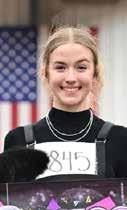

the HY-Plains Feedyard and there were other Brangus and Angus operations that would love to host us for a visit. Our amazing director of youth activities, Lori Edwards-Dunkerley went to work and planned a very interesting, industry-based conference.



When we arrived in Wichita, Kansas we did some icebreaker activities and went over the overall goal of the week. Then we loaded up in a van and headed to the Cargill Innovation Center a few blocks away from our hotel. There we were given a breakdown of what that facility is used for and then participated in hands-on meat fabrication demonstrations. The gracious staff answered our questions and were passionate about their part in the beef industry. We then had more of a classroom session where we were able to do a beef sensory test and talked more about the consumer side of their operation. If you are not familiar with a beef sensory test it is sampling different steaks and trying to guess what cut or grade they were. This was really fun because everyone thought things taste different; I know this was a highlight of the week. Lastly, Cargill continued their amazing hospitality by serving us a carne asada dinner and used the meat that we had watched being fabricated earlier in the tour. I thoroughly enjoyed my time at the Cargill facility and thought this was a great introduction to the tours ahead.
The next morning our group headed out to Paxico, Kansas where we would tour Hurla Farms, a Brangus-based grow yard. We learned that this is a family-owned and operated business that has been open for around twenty-seven years and they can hold two to three thousand head of cattle at a time. I think I can speak for everyone on the trip and say that we were ecstatic to see some Brangus cattle and learn how they perform in this section of the beef industry. It was very interesting to learn about the processes they stand behind. For example, not pushing the cattle too fast when they arrive at the grow yard and letting them build some frame, muscle and intramuscular fat before pushing them to be ready to move to the feedyard and packing plants. Hurla Farms also emphasized that quality
I am incredibly grateful for the opportunity the IJBBA Legacy Conference gave me to explore different areas of the beef industry beyond the show ring with talented people I now call friends. I knew I would enjoy it but the knowledge and fun was far beyond what I could have expected. Thank you IJBBA!
Johnson
EPDs and genetics makes their job easier and ultimately a better product for consumers.

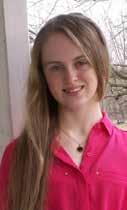




On the flip side, another one of our stops, HY-Plains Feedyard in Montezuma, Kansas is a larger-scale feedyard that comfortably holds 50,000 head at one time. I was in awe of their stateof-the-art facilities and cutting-edge technology. As we drove through the pens and eleven-mile-long feed bunks it was so fascinating to see the assortment of cattle in each pen and all of the data they could collect just from the animal sticking their head through the feed bunk. They also said the most important thing is finding cattle that will make you the most money on the grid. It made me proud to see the pens of Brangus cattle performing well in huge operations like this!
We rounded out the trip with a visit to the Gardiner Angus Ranch in Ashland, Kansas. It was an amazing opportunity to visit an operation that is known for the highest quality of cattle and their exceptional customer service. The family-operated ranch focuses on improving every aspect of their business, especially genetic selection. It was easy to see how much pride they take in their cattle and showcase them by having a state-of-the-art sale facility that also shows the history of their ranch.
Overall, my time at the IJBBA Legacy Conference will
Attending this leadership conference opened my eyes to the production side of the agriculture industry. Seeing Brangus cattle perform at the highest levels was an enlightening experience. Getting to network with industry leaders was a valuable experience that I am very grateful for! It was a wonderful trip getting to create lifelong friendships and memories!
- Briana HicksWhat impacted me most from this conference was getting to learn about other sectors of the beef cattle industry. This was an incredible opportunity, and I learned a lot. I think Gardiner Ranch in Kansas was my favorite, because they are so unique, and had so much to offer both from a management and genetic standpoint. I would like to be able to visit other ranches like that in the future, or even come back and learn more about their operation. Overall, I learned more about other parts of the beef industry, saw thousands of acres of beautiful, desolate country, gained a better understanding of the connection between producers, growers, feedlots, and packers, and am very glad I was able to attend.
Ahna SinclairThe Legacy Conference Trip was such an amazing experience. As a junior growing into a breeder, it was very interesting to see the whole process from a calf to the feed lots to the packaging plants. Getting to know and ask questions to top industry leaders from Cargill, Hy-Plains, Hurla Farms, and Gardiner Angus affirms and increases my purpose to be in the industry. We are cattle breeders and I want to be able to be a part of the process how to make genomically better cattle to produce better meat.



- April Villarreal

go down as one of my favorite trips to date! While no one will be calling us to come play golf for them anytime soon, the ten of us that were piled into that van made some awesome memories that will last us a lifetime! I would not want to spend time traveling through Kansas with any other individuals. Experiences like these only grow my passion for the livestock industry, because they allowed me to meet people who are making a real difference and standing up for what they believe in. I cannot thank the Brangus breed enough for providing me with some of my best friends, greatest accomplishments, and life-changing opportunities. I encourage all junior members to attend a Legacy conference if they ever have the opportunity!






When I was asked to write this article, I knew that the title would be the old quote from General Patton. Lead, follow or get out of the way sums up the three things we can do as it relates to evaluating EPDs globally on Brangus cattle. This idea is not new as it has been kicked around at IBBA for several years now. The broad picture of it is pretty cool to view. Imagine being able to add the EPDs of Brangus cattle from all over the world to our monthly EPD run at IBBA. Many of those cattle have strong pedigree ties to US genetics. Not only would it strengthen the integrity of our current EPDs, but it would also finally allow us to compare EPDs with our international customers on a level playing field.

The answer has three parts...
What is the demand for this type of product on the global stage?
What Will it cost to build?
are the other countries or individual breeders Willing to pay their part?
The obvious question is, "if this is so great, why hasn't it been done yet?"
As the board of directors of IBBA, we all wanted to have clear answers to these questions before we were willing to sign off on a project like this. The last thing any of us want is to build the field of dreams with our breeders’ hard-earned money and just hope the rest of the world shows up.
First, we needed to know the demand. IBBA is currently working with a few international associations to do similar projects. We are currently launching a registration product with Association Brangus Mexicana. We will also be running their EPDs with ours on a monthly basis going forward. We are also in negotiations with Angus Australia to run their Ultra Black cattle’s EPDs monthly. At this point, it appears to be down to coming to terms with compensation. We are also currently in talks with the other association in Mexico to develop a similar product to the one we are launching with ABM. We knew that we had demand in Mexico and Australia but what about the rest of the world? The best place to answer that question was at the World Brangus Congress in Argentina this spring.
Several members and staff attended WBC in Argentina this spring. Our message was clear to Brangus breeders in attendance from around the globe. If we build it, will you join? The response we received from other countries was loud and clear that this project was something that they were interested in. At that point, we took the idea to our Long Range Planning Committee. Long Range Planning signed off on it with a few stipulations.
decision to answer the question posed with the title of this article. Do we lead, follow or get out of the way?
If it makes sense financially, obviously we would want to be in the leading role. We changed our name from the American Brangus Breeders Association to the International Brangus Breeders Association for a reason. If we don’t lead it but we think it’s a good idea how would that work?
The idea was moved to the board of directors in June and was unanimously passed. A committee was appointed to evaluate the unanswered questions of the project and report back to the board by the Houston meeting next March. That Houston board meeting will be exciting to attend. The board will be faced with the
There is another national Brangus association that made it very clear to us that they have the same plans that we do. I don’t know how the rest of you feel but our predecessors started this association 50 miles from my house in Vinita, Oklahoma in 1949 and I’d hate to be the one to tell them that we handed the keys over to another country. The one thing that must be held to no matter what is to make sure this deal makes sense financially. If it doesn’t, that’s when hopefully we have sense enough to get out of the way.

125 Registered Lots grossed $723,250 to average $5,786
Buyers from 6 states were on hand to compete for the high quality lots consigned by 20 breeders across the Southeast. The highest selling lot MS. Boulder 000F16 with a heifer calf at her side, consigned by Vanna Farms, was purchased by L & K Farms for $26,000.
The volume buyer was Eagle Ridge Farms, Cottondale, Al -purchased 12 lots

All consigners and buyers are greatly appreciated. The 2023 Cut Above Sale will be in Cullman, AL on April 29, 2023 at 10:00 am
CAVENDER DRAGGIN’ M AND PARTNERS SPRING SALE
Registered Female Sale
1 Registered Brangus Herd Sire grossed $15,000 to average $15,000
Lot 1: QVF MS NEVER SURRENDER 30G3 sold for $76,000 to Strickland Sod Farm. She was consigned by Phillips Ranch and Quail Valley Farms.
Commercial Females
324 Commercial pairs with Brangus and Ultrablack calves at side grossed $890,500 to average $2,748
59 Brangus and Super Baldy Bred Heifers grossed $140,950 to average $2,389
Lot 2: BWCC MS OVERLOAD 468D22 sold for. $75,000 to Genetic Partners. She was consigned by Vanna Farms and Saddle Hill
66 Open Brangus Heifers grossed $140,050 to average $2,122
449 Commercial Females grossed $1,171,500 to average $2,609
High Selling Fall Bred Heifers -

163 buyers from 12 states and Mexico were greeted by pleasant spring weather, mild temperature and welcoming hospitality from the hosts at Cavenders Neches River Ranch.
Lot 11: PRB MS N SURRENDER 30J31 sold for $33,000 to Cavender Brangus. She was consigned by Phillips Ranch.
Lot 27: FC MS EMPOWER 468J4 sold for $30,000 to American Cattle Enterprises. She was consigned by Fenco Farms.
High Selling Open Fall Heifer -
at the 2nd annual CDP Spring Female Production Sale. The sale featured Registered Brangus and Ultrablack cattle from the CDP group as well as customers and included 450 commercial cattle, many with calves at side sired by CDP bulls. The bidding was fast paced and furious as demand for quality Brangus seedstock ran high.
Lot 7A: VF MS HUGO 000K20 sold for $25,000 to Phillips Ranch. She was consigned by Vanna Farms.
High Selling Spring Bred/Exposed Heifer -
The day’s top selling female, at $25,000 was Lot 85, PR MS Crossroads 129J7. This powerful open heifer was consigned by Pennridge Farms, Paige, Tx. Her dam is a full sister to the dam of Modello and Herndon Farms, Lyons, Ga was the winning bidder.
Briggs Ranch, Bloomington TX and Harris Riverbend Farms, Cleburne, TX teamed to eran the bid of $24,000 for Lot 107, MS DMR Resource 415J52. She was another stout open heifer and was consigned by CDP Partner, Draggin M Ranch, Eldorado, Arkansas.
Lot 23: PRB MS CROSS FIT 406J9 sold for $20,000 to Villa Ranch. She was consigned by Phillips Ranch.
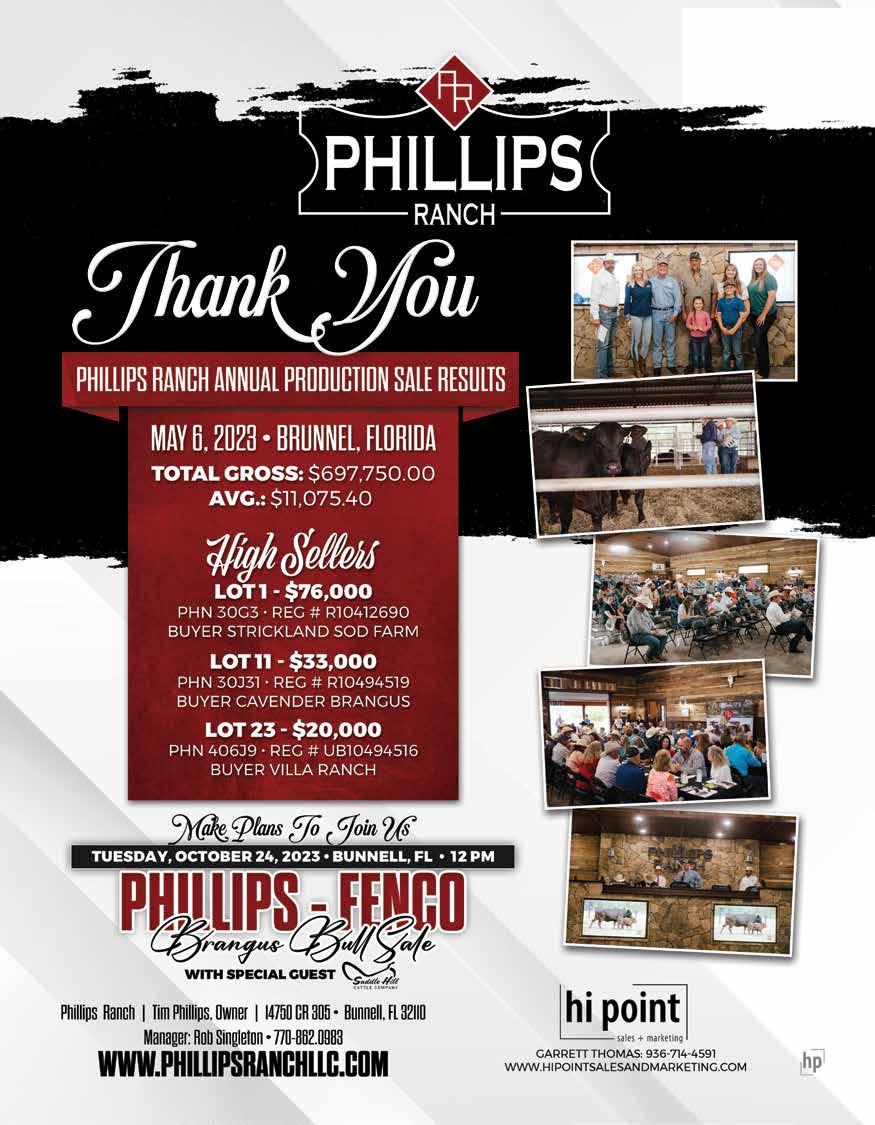
Monty
GKB
Female Divisions:
Heifer Calf Champion: ACC KATALINA
358K2, Chloe Wise, North Zulch, TX
Reserve Heifer Calf Champion: TCR ELIZAMA
302L1, Triple Crown Ranch, Angleton, TX
Summer Yearling Champion Heifer: RAFTER L VEGA JO 157K4, Lucherk Cattle, McCoy, TX
Tajo
KO’s
Reserve Summer Yearling Champion Heifer: TCR MIRABEL 302K10, Triple Crown Ranch, Angleton, TX



Yearling Champion Heifer: ACC KIMBER 674K3, Katherine Allen, Crockett, TX

Tajo
Klaire Horner, Tuscola, Texas
Reserve Yearling Champion Heifer: GKB
TANKS LADY KATHY 149K, GKB Cattle, Desdemona, TX
Junior Champion Heifer: TCR REINA 302J14, Triple Crown Ranch, Angleton, TX
Reserve Junior Champion Heifer: MP MS
MIDNIGHT STAR 804J38, MP Brangus, Waco, TX
Senior Champion Heifer: TCR BELINDA
302J8, Railee Steele, Gainesville, FL
Reserve Senior Champion Heifer: SB MS
CROSSCUT 313J5, Eris Basey, Florence, TX
Red Female Divisions:
Red Heifer Calf Champion: TAJO MS VELVITA 204K6, Tajo Ranch, Waller, TX, KO’s Cattle Service, Waxahachie, TX


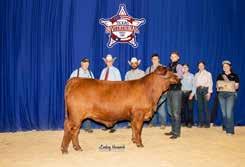


Red Reserve Heifer Calf Champion:LV MISS KILLEEN, Lane Vann, Normangee, TX
Red Summer Yearling Champion Heifer: MS
BROKEN A KATHERINE 14K,
Reagan Reeves, Livingston, TX
Red Reserve Summer Yearling Champion Heifer: VILLAS MS CATALINA 71K11, Villa Ranch, Brookshire, TX
Red Yearling Champion Heifer: TAJO
CATALINA 59K5, Truitt Marks, Waxahachie, TX, Tajo Ranch, Waller, TX, KO’s Cattle Service, Waxahachie, TX

Red Reserve Yearling Champion Heifer: GKB
MISS RED VELVET 204K4,
Monty Eskew, Tarzan, TX
Red Junior Champion Heifer: MS SENDERO
JLO 59J2, TRIO Cattle and Genetics, Mabank, TX, Sendero Red Brangus, Laredo, TX
Red Reserve Junior Champion Heifer: DOS XXS
DYNAMITES JADE,
Logan Woodruff, El Campo, TX
Red Senior Champion Heifer: KTS MS STELLA
800J, Truitt Marks, Waxahachie, TX
Red Reserve Senior Champion Heifer: CX MS
DH'S CHI CHI 59J3, Cox Excalibur Brangus, Katy, TX
Bull Divisions:
Bull Calf Champion: BB TANK 150K5, Camille Burns, Wharton, TX


Reserve Bull Calf Champion: ACC GOOD
TIMES 674K16, Katherine Allen, Crockett, TX
Summer Yearling Champion Bull: ORIGINS
KNOCK OUT 302K2, MP Brangus, Waco, TX,
RPX Somerville Farms, Houston, TX,
GKB Cattle, Desdemona, TX
Reserve Summer Yearling Champion Bull: KL
NAVIGATOR 915K1, K&L Brangus, Gillett, TX
Junior Yearling Champion Bull: GKB
UNMATCHED 804K10,
GKB Cattle, Desdemona, TX
Reserve Junior Yearling Champion Bull: BB
CROSS CANADIAN 150K3, Quinn Burns, Wharton, TX
Senior Yearling Champion Bull: ACC HIGH
FIVE 674J15, Katherine Allen, Crockett, TX
Reserve Senior Yearling Champion Bull: WRC
FIVE STAR 915J63, G Bar Brangus, Beckville, TX
Junior Champion Bull: 6B JOHN BOY 804J10, Eris Basey, Florence, TX
Red Bull Divisions:
Red Bull Calf Champion: HB EXCALIBURS
DREAM 948K, Cox Excalibur Brangus, Katy, TX
Grand Champion Brangus Bull
6B JOHN BOY 804J10
Eris Basey, Florence, Texas
Reserve Champion Brangus Bull
ORIGINS KNOCK OUT 302K2
MP Brangus, Waco, Texas
RPX Somerville Farms, Houston, Texas
GKB Cattle, Desdemona, Texas
Grand Champion Red Brangus Bull
TAJO NIGHT CAP 307K2
Tajo Ranch, Waller, Texas
KO’s Cattle Service, Waxahachie, Texas
Red Reserve Bull Calf Champion: TAJO
WOOPA 204K22, Tajo Ranch, Waller, TX, KO’s Cattle Service, Waxahachie, TX
Red Summer Yearling Champion Bull: BROKEN
A MAVERICK 841K2, Broken A Ranch, Madisonville, TX
Red Junior Yearling Champion Bull: TAJO
NIGHT CAP 307K2, Tajo Ranch, Waller, TX, KO’s Cattle Service, Waxahachie, TX
Red Reserve Junior Yearling Champion Bull: DOS XX'S BO'S DAGGAR, Dos XX’s Cattle Co., Washington, TX
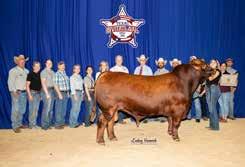

Reserve Champion Red Brangus Bull VILLA'S VALENTINO 59J14
Villa Ranch, Brookshire, Texas
Red Junior Champion Bull: VILLA'S VALENTINO 59J14, Villa Ranch, Brookshire, TX
Red Reserve Junior Champion Bull: AP MR TED 153/J, AP Cattle, Pealand, TX
Red Senior Champion Bull: PCC TRIO'S FFF
HURACAN 101H3, TRIO Cattle & Genetics, Mabank, TX, Genetica Triple F, Tepatitlan, Jalisco, Mexico, MBJ Ranch, Wharton, TX, Sendero Red Brangus, Laredo, TX
Red Reserve Senior Champion Bull: CX
HOMBRE'S HOME RUN 59J10, Cox Excalibur Brangus, Katy, TX

GKB MISS BELLA 118J
GKB Cattle, Desdemona, Texas
Reserve
CT MS FINLEY 108J2
Carlee Taylor, Lakeland, Florida
Judge: Chris Sankey and Jojo Carrales
Reserve
Ultrablack/Ultrared Pair FARRIS MS SEGWAY 66J
Genna Minyard, Ovalo, Texas
Grand
Ultrablack/Ultrared Bull CHAMP MR LIMITLESS 150J7
Champions Valley Brangus, Schulenburg, Texas
Ultra Female Divisions:
Ultra Heifer Calf Champion: ACC QUEEN OF CLASS 674K11, Briana Hicks, Alvin, TX
Ultra Reserve Heifer Calf Champion: GKB MISS SWEETIE 38L, GKB Cattle, Desdemona, TX
Ultra Yearling Champion Heifer: GKB DIXIE LADY 436K7, GKB Cattle, Desdemona, TX

Ultra Reserve Yearling Champion Heifer: TT MS PENNY 121K, Truman Taylor, Lakeland, FL
CT DEEP POCKETS 108K2
Carlee Taylor, Lakeland, Florida
Ultra Junior Champion Heifer: GKB MISS BELLA 118J, GKB Cattle, Desdemona, TX
Grand
CT MS SPECIAL LADY 814G
Carlee Taylor, Lakeland, Florida
Ultra Reserve Junior Champion Heifer: CT MS FINLEY 108J2, Carlee Taylor, Lakeland, Florida
Ultra Senior Champion Heifer: FARRIS MS ULTRA SEGWAY 59J, Kennedy Horner, Tuscola, TX
Ultra Bull Divisions:
Ultra Summer Yearling Champion Bull: SCCC KADILLAC 804K, Roxton Stone, Stanton, TX
Ultra Junior Yearling Champion Bull: CT DEEP POCKETS 108K2, Carlee Taylor, Lakeland, FL
Ultra Senior Yearling Champion Bull: CHAMP MR LIMITLESS 150J7, Champions Valley Brangus, Schulenburg, TX


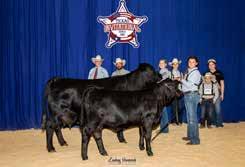


Ultra Junior Champion Bull: DIAMOND JV JOKER 23J, Cheyene Durheim, Spring, TX
 Grand Champion Ultrablack/Ultrared Female
Champion Ultrablack/Ultrared Female
Champion Ultrablack/Ultrared Pair
Champion
Reserve Champion Ultrablack/Ultrared Bull
Champion
Grand Champion Ultrablack/Ultrared Female
Champion Ultrablack/Ultrared Female
Champion Ultrablack/Ultrared Pair
Champion
Reserve Champion Ultrablack/Ultrared Bull
Champion

June 6, 2023

Contact: Joe Cavender (903) 571-1209
A New Era for Cavender Ranches
Joe Cavender, Cavender Ranches, Tyler, Texas recently announced the decision to become an independent Brangus and Charolais cattle producer. “I have made a lot of close friends and have enjoyed working with and respect our partners in both Genetrust and Cavender-Draggin’ M and Partners. However, I feel like the time has come for Cavender Ranches to be on our own,” says Joe.
“As our operation continues to grow both numerically and in quality, we feel being independent gives us more long-term Vlexibility in marketing bulls, females, semen and embryos and the utilization of the real-world carcass data we are able to glean. It helps us better address the needs of our customers and cooperators in terms of providing greater market access and premium marketing opportunities both at the registered and commercial level,” added Joe Cavender.
Cavender Ranches have been involved in the Brangus breed for over 30 years and made a commitment to feed all their commercial steers and non-replacement quality females over 25 years ago. The feed lot data gained through this endeavor has been an important factor in our decisionmaking process and breeding program. Cavender Ranches remains both a seedstock producer and an end user of their product through their commercial herds and feedlot programs.
The Cavender management team remains intact with Justin Matejka continuing to serve as General Manager of Cavender Ranches and Dustin Kennedy remaining the Purebred Cattle Manager. Also assisting in customer service and marketing are Mark Cowan and Todd Harvey.
Cavender Ranches will continue to host their annual bull and female sale the third weekend in November, their Spring Bull Sale the second weekend in March and their Spring Female Production Sale the fourth weekend in April.
Cavender Ranches will remain focused on providing genetically superior, performance driven registered and commercial cattle. Our commercially focused operation will continue to feed our own steers and assist our customers in their marketing efforts, both commercially and in the registered seedstock sectors of the industry.






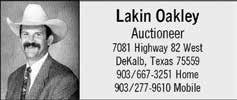








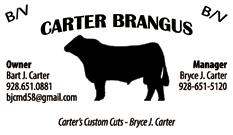

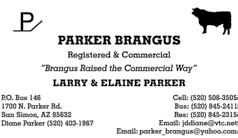









JOHN MILAM, OWNER Grady Green, Ranch Manager 870-314-3673 | grady@dragginmranch.com El Dorado, Arkansas www.dragginm.com













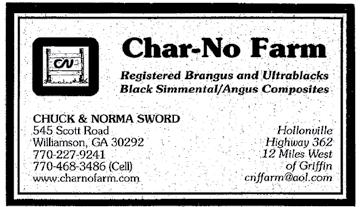

















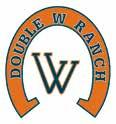
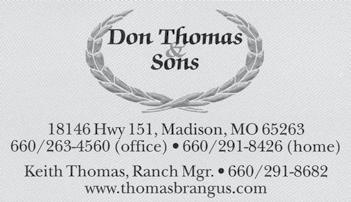








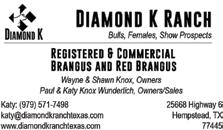











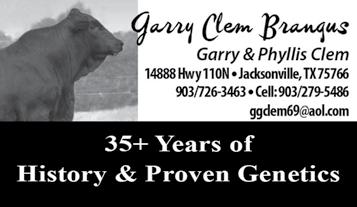



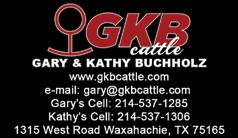


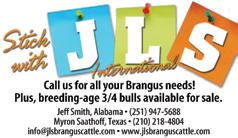






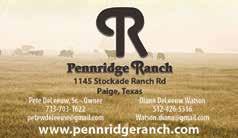



















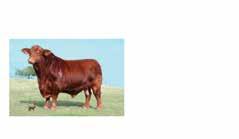






















JOURNAL The International Brangus Breeders Association (IBBA) is proud to offer its members and industry affiliates the opportunity to promote themselves through Brangus Publications, Inc.’s (BPI) print and digital mediums. IBBA’s printed publications are produced by BPI and are distributed to a mailing list, comprised of addresses in Australia, Colombia, Costa Rica, Mexico, Philippines, Thailand, and the United States; with a circulation of approximately 2,000.
The Brangus Journal (ISSN 0006-9132) is published by Brangus Publications, Inc. (BPI), 8870 US Highway 87 East, San Antonio, Texas 78263, monthly except February, June, July, and September. Periodicals postage paid at San Antonio, Texas and additional mailing offices. POSTMASTER: send address change to Brangus Publications Inc., P.O. Box 809, Adkins, Texas 78101.
The Brangus Journal is the official publication of the International Brangus® Breeders Association (IBBA). The Brangus Journal is published eight times annually. The purpose of the Brangus Journal is to serve the best interest of IBBA members by showcasing breeding programs, efforts, and achievements to other Brangus® seedstock producers. Lastly, the Brangus Journal serves as an outlet for the IBBA to provide updates by directly communicating with the membership. The claims made by advertisers in this publication are not verified by BPI or the IBBA. For subscriptions, email info@gobrangus.com, or call 210.696.8231. Domestic periodicals (one year) $25; first class $55; foreign periodicals (one year) $25; air mail to Canada or Mexico $70; air mail to other countries $115.
